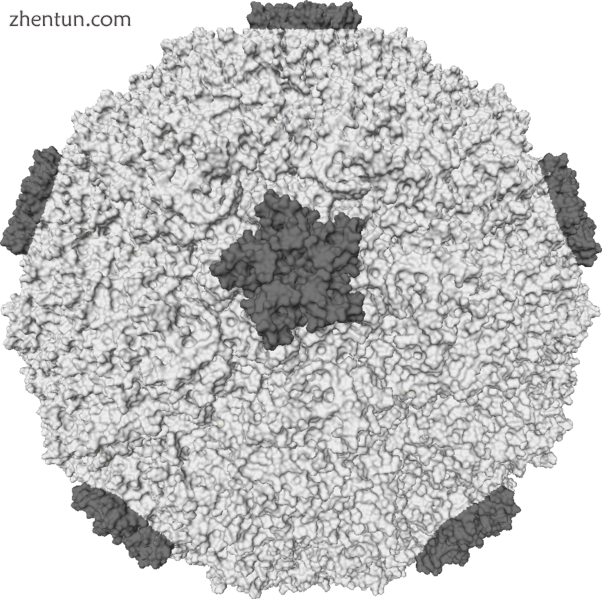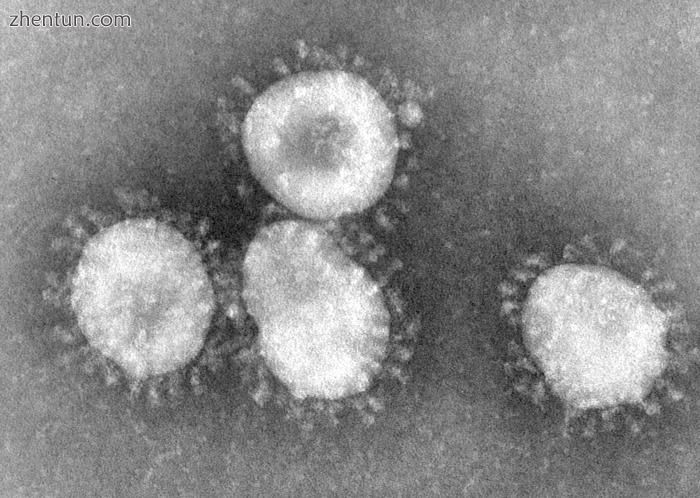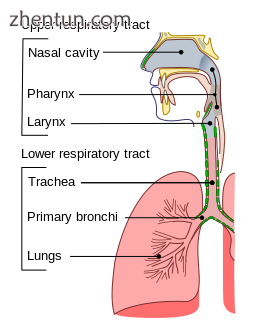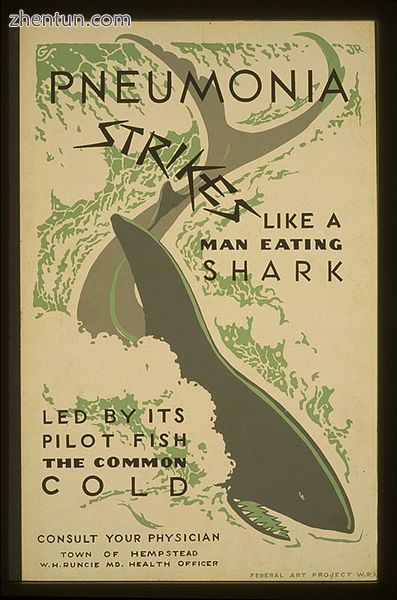普通感冒,也简称为感冒,是一种主要影响鼻子的上呼吸道病毒感染性疾病。[7]喉咙,鼻窦和喉部也可能受到影响。[5]接触病毒后不到两天就会出现体征和症状。[5]这些可能包括咳嗽,喉咙痛,流鼻涕,打喷嚏,头痛和发烧。[2] [3]人们通常在七到十天内康复,[2]但有些症状可能持续三周。[6]偶尔有其他健康问题的人可能会患上肺炎。[2]
超过200种病毒株引起普通感冒,其中鼻病毒是最常见的。[11]它们在与受感染的人密切接触时通过空气传播,或通过接触环境中的物体间接传播,然后转移到口腔或鼻子。[2]风险因素包括去托儿所,不能好好睡觉,以及心理压力。[5]症状主要是由于身体对感染的免疫反应,而不是病毒本身对组织的破坏。[12]相反,受流感影响的人可能会表现出与感冒患者相似的症状,但症状通常更严重。[5]此外,流感不太可能导致流鼻涕。[13]
普通感冒没有疫苗。[2]预防的主要方法是洗手;用未洗过的手不要接触眼睛,鼻子或嘴巴;远离病人。[2]一些证据支持使用口罩。[14]也没有治愈方法,但可以治疗症状。[2]如果在症状出现后不久就开始服用,锌可能会减少症状的持续时间和严重程度。[8]非甾体类抗炎药(NSAIDs)如布洛芬可能有助于疼痛。[9]但是,不应该使用抗生素[15]并且没有良好的咳嗽药物证据。[5] [16]
普通感冒是人类最常见的传染病。[17]一般成年人每年感冒两到三次,而普通儿童可能感染六到八次。[7] [10]感染在冬季更常见。[2]这些感染在整个人类历史中都存在。[18]

人鼻病毒的一种变体的分子表面的代表
目录
1 症状和体征
1.1 进展
2 原因
2.1 病毒
2.2 传输
2.3 天气
2.4 其他
3 病理生理学
4 诊断
5 预防
6 管理
6.1 症状
6.2 抗生素和抗病毒药物
6.3 替代医学
7 预后
8 流行病学
9 历史
10社会与文化
11 研究方向
12 参考
体征和症状
感冒的典型症状包括咳嗽,流鼻涕,打喷嚏,鼻塞和喉咙痛,有时伴有肌肉酸痛,疲劳,头痛和食欲不振。[19]约40%的病例出现喉咙痛,约50%出现咳嗽[7],而肌肉疼痛约占一半[3]。在成人中,通常不会发烧,但在婴幼儿中常见。[3]与伴随流感的咳嗽相比,咳嗽通常是轻微的[3]。虽然咳嗽和发烧表明成人患流感的可能性较高,但这两种情况之间存在很大的相似性。[20]许多引起普通感冒的病毒也可能导致无症状感染。[21] [22]
痰液或鼻腔分泌物的颜色可能从透明到黄色变为绿色,并不表示引起感染的药剂类别。[23]
级数
感冒通常始于疲劳,感到寒冷,打喷嚏和头痛,几天后流鼻涕和咳嗽。[19] 症状可能在接触后16小时内开始[24],通常在发病后2至4天达到峰值。[3] [25] 他们通常在七到十天内解决,但有些人可以持续长达三周。[6] 平均咳嗽持续时间为18天[26],在某些情况下,人们会感染病毒后咳嗽,感染后可以徘徊。[27] 对于儿童,35-40%的病例咳嗽持续超过10天,持续超过25天,持续10%。[28]
原因
病毒

冠状病毒是一组以引起普通感冒而闻名的病毒。当在电子显微镜下观察时,它们具有光晕或冠状(电晕)外观。
普通感冒是上呼吸道的病毒感染。最常见的病毒是鼻病毒(30-80%),一种具有99种已知血清型的小核糖核酸病毒。[29] [30]其他常见的病毒包括人类冠状病毒(约15%),[31] [32]流感病毒(10-15%),[33]腺病毒(5%),[33]人呼吸道合胞病毒,鼻病毒以外的肠道病毒,人副流感病毒和间质肺病毒。[34]通常存在不止一种病毒。[35]总共超过200种病毒类型与感冒有关。[3]
传输
普通感冒病毒通常通过空气传播的飞沫(气溶胶)传播,直接接触受感染的鼻腔分泌物或污染物(受污染的物体)。[7] [36]其中哪些路线至关重要尚未确定。[37]这些病毒可以在环境中长时间存活(鼻病毒超过18小时),并且可以被人们的手捡起,然后被带到感染发生的眼睛或鼻子。[36]由于许多儿童靠近许多免疫力较差且卫生条件较差的儿童,传播在日托和学校都很常见。[38]然后将这些感染带回家中的其他成员。[38]没有证据表明商业飞行期间的再循环空气是一种传播方式。[36]坐在附近的人似乎有更大的感染风险。[37]
在病症的前三天,鼻病毒引起的感冒最具感染性;事后他们的传染性要小得多。[39]
天气
传统的理论认为,感冒可以被长期暴露在寒冷天气(如雨水或冬季条件)中“捕获”,这就是疾病的名称。[40]导致感冒的一些病毒是季节性的,在寒冷或潮湿的天气中更频繁发生。[41]季节性的原因尚未确定。[42]可能的解释可能包括呼吸系统的低温引起的变化,[43]免疫反应降低[44]和低湿度导致病毒传播率增加,可能是由于干燥空气使小病毒液滴分散得更远并留在空气更长。[45]
明显的季节性也可能是由于社会因素造成的,例如人们在室内,感染者附近花费更多时间,[43]特别是在学校的儿童。[38] [42]关于低体温作为普通感冒危险因素的作用存在一些争议;大多数证据表明它可能导致更大的感染易感性。[44]
其他
先前暴露于感冒病毒产生的畜群免疫在限制病毒传播方面起着重要作用,正如年轻人群中呼吸道感染率较高所见。[46]免疫功能低下是疾病的危险因素。[46] [47]睡眠不足和营养不良与鼻病毒暴露后发生感染的风险增加有关;这被认为是由于它们对免疫功能的影响。[48] [49]母乳喂养降低了急性中耳炎和下呼吸道感染等疾病的风险,[50]并且建议在婴儿感冒时继续母乳喂养。[51]在发达国家,母乳喂养可能无法预防普通感冒。[52]
病理生理学

普通感冒是上呼吸道疾病。
据信,感冒的症状主要与对病毒的免疫反应有关。[12]这种免疫反应的机制是病毒特异性的。例如,鼻病毒通常通过直接接触获得;它通过未知机制通过ICAM-1受体和CDHR3受体与人类结合,从而触发炎症介质的释放。[12]然后这些炎症介质产生症状。[12]它通常不会对鼻上皮造成损害。[3]另一方面,呼吸道合胞病毒(RSV)通过直接接触和空气传播的液滴收缩。然后它在鼻子和喉咙中复制,然后经常扩散到下呼吸道。[53] RSV确实会导致上皮损伤。[53]人副流感病毒通常会导致鼻子,喉咙和支气管发炎。[54]在幼儿中,当它影响气管时,由于气道小,可能会产生哮喘的症状。[54]
诊断
病毒性上呼吸道感染的区别主要取决于症状的位置,普通感冒主要影响鼻子,咽炎(咽喉)和支气管炎(肺部)。[7]可能存在重大的重叠,并且可能会影响多个区域。[7]普通感冒经常被定义为鼻腔炎症,伴有不同程度的喉部炎症。[55]自我诊断经常发生。[3]很少进行病毒介导的分离,[55]并且通常不可能通过症状来识别病毒类型。[3]
预防
减少感冒病毒传播的唯一有用方法是物理措施[14],如洗手和面罩;在医疗保健环境中,也使用礼服和一次性手套。[14]不使用隔离或隔离,因为疾病如此普遍并且症状是非特异性的。由于涉及许多病毒并且它们迅速发生变异,疫苗接种已证明是困难的。[14]因此,创造一种广泛有效的疫苗极不可能。[56]
定期洗手似乎可有效减少感冒病毒的传播,尤其是儿童。[57]是否在正常洗手中添加抗病毒药物或抗菌药物能否带来更大益处尚不清楚。[57]在被感染的人周围戴口罩可能是有益的;然而,没有足够证据证明维持更大的社交距离。[57]
目前尚不清楚锌补充剂是否会影响患感冒的可能性。[58] 常规维生素C补充剂不会降低感冒的风险或严重程度,但可能会缩短其持续时间。[59] 在一项小型试验中发现用水漱口是有用的。[60]
管理

1937年的海报鼓励市民“咨询你的医生”治疗感冒
普通感冒的治疗主要涉及药物治疗和其他症状缓解疗法。[10]获得充足的休息,饮用液体以保持水分,并用温盐水漱口是合理的保守措施。[34]然而,对症治疗的大部分益处归因于安慰剂效应。[61]最终没有药物或草药可以缩短感染时间。[62]
症状
可能有助于症状的治疗包括简单的止痛药和发烧药物,如布洛芬[9]和对乙酰氨基酚(扑热息痛)。[63]然而,目前尚不清楚对乙酰氨基酚是否有助于症状。[64]目前尚不清楚非处方止咳药物是否对治疗急性咳嗽有效。[65]由于缺乏支持有效性和可能造成伤害的证据,不建议将咳嗽药物用于儿童。[66] [67] 2009年,由于担心风险和未经证实的福利,加拿大限制在6岁及以下儿童使用非处方咳嗽和感冒药物。[66]滥用右美沙芬(一种非处方咳嗽药)导致其在一些国家被禁止使用。[68]尚未发现鼻内皮质类固醇有用。[69]
在成人中,短期使用鼻腔减充血剂可能会带来很小的好处。[70]抗组胺药可在第一天或第二天改善症状;然而,没有长期效益,它们会产生嗜睡等不良影响。[71]其他减充血剂如伪麻黄碱在成人中似乎有效。[72] [70]异丙肾上腺素喷雾可以减轻流鼻涕的症状,但对闷热几乎没有影响。[73]鼻用减充血剂在儿童中的安全性和有效性尚不清楚。[70]
由于缺乏研究,尚不清楚增加液体摄入是否可改善症状或缩短呼吸道疾病。[74]截至2017年,加热和加湿的空气效果不明显。[75]一项研究发现胸部揉搓可以缓解夜间咳嗽,充血和睡眠困难。[76]
有人建议如果出现发烧,广泛的肌肉疼痛或疲劳等症状,应避免进行体育锻炼。[77] [78]如果症状局限于头部,包括流鼻涕,鼻塞,打喷嚏或轻微的喉咙痛,则进行适度运动被认为是安全的。[77] [78]有一个老妻子的故事,喝热饮可以帮助解决感冒症状,但支持这一点的证据非常有限。[79]
抗生素和抗病毒药物
抗生素对病毒感染或导致感冒的病毒没有影响。[80]由于它们的副作用,抗生素会造成整体伤害,但仍然经常开处方。[80] [81]抗生素如此普遍处方的一些原因包括人们对它们的期望,医生的求助意愿,以及难以排除可能适合抗生素的并发症。[82]尽管一些初步研究已显示出有益效果,但普通感冒药并没有有效的抗病毒药物。[10] [83]
替代药物
虽然有许多替代疗法用于普通感冒,但没有足够的科学证据支持大多数人的使用。[10]截至2018年,没有足够的证据建议支持或反对蜂蜜。[84]截至2015年,有临时证据支持鼻腔冲洗。[85]
如果在症状出现后24小时内开始补充,锌补充剂可缩短持续时间并减轻症状的严重程度。[8] [58] [86] [87]一些直接涂在鼻子内部的锌补救措施导致嗅觉丧失。[88]然而,2017年专家小组发现证据不足以推荐锌的使用。[16]
维生素C对普通感冒的影响虽然经过广泛研究,但令人失望,除非在有限的情况下:特别是在寒冷环境中大力锻炼的人。[59] [89]没有确凿的证据表明紫锥菊产品在治疗或预防感冒方面有任何有意义的益处。[90]目前尚不清楚大蒜是否有效。[91]单次维生素D试验未发现有益效果。[92]
预测
普通感冒通常是轻度和自限性的,大多数症状一般在一周内有所改善。[7]一半案件在10天内消失,90%在15天内消失。[93]严重的并发症,如果发生,通常是在很老的,非常年轻的,或免疫抑制的。[17]可能发生继发性细菌感染,导致鼻窦炎,咽炎或耳部感染。[94]据估计,鼻窦炎发生率为8%,耳部感染发生率为30%[95]。
流行病学
普通感冒是最常见的人类疾病[17]并影响到全球人民。[38]成人通常每年有两到三次感染,[7]儿童每年可能有六到十次感冒(学龄儿童每年最多感冒十二次)。[10]由于免疫力下降,老年人的症状感染率增加。[46]
美国原住民和因纽特人更容易感染感冒,并且比白种人更容易出现中耳炎等并发症。[33]这可以通过诸如贫穷和过度拥挤而不是种族等问题来解释。[33]
历史
![A British poster from World War II describing the cost of the common cold[96].jpg A British poster from World War II describing the cost of the common cold[96].jpg](data/attachment/forum/201904/07/213946tbnql0bqnztpnbpn.jpg)
第二次世界大战中的英国海报描述了普通感冒的费用[96]
虽然自20世纪50年代以来才发现普通感冒的原因,但这种疾病在整个历史中一直伴随着人类。[18]它的症状和治疗描述于埃及埃伯斯纸莎草纸,这是现存最古老的医学文本,写于公元前16世纪。[97]由于其症状与暴露于寒冷天气之间的相似性,“寒冷”这个名称在16世纪开始使用。[98]
在英国,普通感冒病房由医学研究委员会于1946年成立,它是1956年发现鼻病毒的地方。[99]在20世纪70年代,CCU证明在鼻病毒感染的孵育阶段用干扰素治疗可以在一定程度上防止疾病[100],但是不能开发出实际的治疗方法。该单位于1989年关闭,两年后,它完成了葡萄糖酸锌含片预防和治疗鼻病毒感冒的研究,这是该单位历史上唯一成功的治疗方法。[101]
社会与文化
在世界许多地方,人们对普通感冒的经济影响尚不了解。[95]在美国,普通感冒每年导致75-100万医生就诊,保守估计费用为每年77亿美元。美国人在非处方药上花费29亿美元,在症状缓解的处方药上花费4亿美元。[102]超过三分之一的看过医生的人接受了抗生素处方,这对抗生素耐药性有影响。[102]由于感冒,估计每年错过22-189万个上课日。结果,父母错过了1.26亿个工作日,待在家里照顾孩子。如果加入到患有感冒的员工错过的1.5亿个工作日,与冷相关的工作损失的总经济影响每年超过200亿美元。[34] [102]这占美国工作时间损失的40%。[103]
研究方向
已经测试了抗病毒药物在普通感冒中的有效性; 截至2009年,没有一项被认定有效且获准使用。[83] 目前正在进行抗病毒药物pleconaril试验,该试验显示对小核糖核酸病毒以及BTA-798的试验具有前景。[104] 口服形式的pleconaril有安全问题,正在研究气溶胶形式。[104] DRACO是一种广谱抗病毒治疗药物,在治疗鼻病毒以及其他传染性病毒方面已初见成效。[105]
已对所有已知人鼻病毒株的基因组进行了测序。[106]
参考:
John, Pramod R. John (2008). Textbook of Oral Medicine. Jaypee Brothers Publishers. p. 336. ISBN 978-81-8061-562-7. Archived from the original on 29 May 2016.
"Common Colds: Protect Yourself and Others". CDC. 6 October 2015. Archived from the original on 5 February 2016. Retrieved 4 February 2016.
Eccles R (November 2005). "Understanding the symptoms of the common cold and influenza". Lancet Infect Dis. 5 (11): 718–25. doi:10.1016/S1473-3099(05)70270-X. PMID 16253889.
Bennett, John E.; Dolin, Raphael; Blaser, Martin J. (2014). Principles and Practice of Infectious Diseases. Elsevier Health Sciences. p. 750. ISBN 978-1-4557-4801-3. Archived from the original on 8 September 2017.
Allan, GM; Arroll, B (18 February 2014). "Prevention and treatment of the common cold: making sense of the evidence". CMAJ : Canadian Medical Association Journal. 186 (3): 190–99. doi:10.1503/cmaj.121442. PMC 3928210. PMID 24468694.
Heikkinen T, Järvinen A (January 2003). "The common cold". Lancet. 361 (9351): 51–59. doi:10.1016/S0140-6736(03)12162-9. PMID 12517470.
Arroll, B (March 2011). "Common cold". Clinical Evidence. 2011 (3): 1510. PMC 3275147. PMID 21406124. Common colds are defined as upper respiratory tract infections that affect the predominantly nasal part of the respiratory mucosa open access
"Zinc – Fact Sheet for Health Professionals". Office of Dietary Supplements, US National Institutes of Health. 11 February 2016. Retrieved 7 January 2018. Although studies examining the effect of zinc treatment on cold symptoms have had somewhat conflicting results, overall zinc appears to be beneficial under certain circumstances.
Kim, SY; Chang, YJ; Cho, HM; Hwang, YW; Moon, YS (21 September 2015). "Non-steroidal anti-inflammatory drugs for the common cold". The Cochrane Database of Systematic Reviews. 9 (9): CD006362. doi:10.1002/14651858.CD006362.pub4. PMID 26387658.
Simasek M, Blandino DA (2007). "Treatment of the common cold". American Family Physician. 75 (4): 515–20. PMID 17323712. Archived from the original on 26 September 2007. open access
"Common Cold and Runny Nose" (17 April 2015). CDC. Archived from the original on 1 February 2016. Retrieved 4 February 2016.
Eccles p. 112
"Cold Versus Flu". 11 August 2016. Archived from the original on 6 January 2017. Retrieved 5 January 2017.
Eccles p. 209
Harris, AM; Hicks, LA; Qaseem, A; High Value Care Task Force of the American College of Physicians and for the Centers for Disease Control and, Prevention (19 January 2016). "Appropriate Antibiotic Use for Acute Respiratory Tract Infection in Adults: Advice for High-Value Care From the American College of Physicians and the Centers for Disease Control and Prevention". Annals of Internal Medicine. 164 (6): 425–34. doi:10.7326/M15-1840. PMID 26785402.
Malesker, MA; Callahan-Lyon, P; Ireland, B; Irwin, RS; CHEST Expert Cough, Panel. (November 2017). "Pharmacologic and Nonpharmacologic Treatment for Acute Cough Associated With the Common Cold: CHEST Expert Panel Report". Chest. 152 (5): 1021–37. doi:10.1016/j.chest.2017.08.009. PMC 6026258. PMID 28837801.
Eccles p. 1
Eccles, Ronald; Weber, Olaf (2009). Common cold. Basel: Birkhäuser. p. 3. ISBN 978-3-7643-9894-1. Archived from the original on 8 May 2016.
Eccles p. 24
Eccles p. 26
Eccles p. 129
Eccles p. 50
Eccles p. 30
Richard A. Helms, ed. (2006). Textbook of therapeutics: drug and disease management (8. ed.). Philadelphia, Pa. [u.a.]: Lippincott Williams & Wilkins. p. 1882. ISBN 978-0-7817-5734-8. Archived from the original on 30 April 2016.
Turner, Ronald B.; Hayden, Frederick G. (2003). "Rhinovirus". In Rübsamen-Waigmann, Helga; et al. Viral Infections and Treatment. New York: CRC Press. p. 111. ISBN 978-0-8247-4247-8. Archived from the original on 4 May 2016.
Ebell, M.H.; Lundgren, J.; Youngpairoj, S. (Jan–Feb 2013). "How long does a cough last? Comparing patients' expectations with data from a systematic review of the literature". Annals of Family Medicine. 11 (1): 5–13. doi:10.1370/afm.1430. PMC 3596033. PMID 23319500. open access
Dicpinigaitis PV (May 2011). "Cough: an unmet clinical need". Br. J. Pharmacol. 163 (1): 116–24. doi:10.1111/j.1476-5381.2010.01198.x. PMC 3085873. PMID 21198555. open access
Goldsobel AB, Chipps BE (March 2010). "Cough in the pediatric population". J. Pediatr. 156 (3): 352–58. doi:10.1016/j.jpeds.2009.12.004. PMID 20176183.
Palmenberg AC, Spiro D, Kuzmickas R, Wang S, Djikeng A, Rathe JA, Fraser-Liggett CM, Liggett SB (2009). "Sequencing and Analyses of All Known Human Rhinovirus Genomes Reveals Structure and Evolution". Science. 324 (5923): 55–59. Bibcode:2009Sci...324...55P. doi:10.1126/science.1165557. PMC 3923423. PMID 19213880.
Eccles p. 77
Pelczar (2010). Microbiology: Application Based Approach. p. 656. ISBN 978-0-07-015147-5. Archived from the original on 16 May 2016.
Russell La Fayette Cecil; Lee Goldman; Andrew I. Schafer (2012), Goldman's Cecil Medicine, Expert Consult Premium Edition (24 ed.), Elsevier Health Sciences, pp. 2103–, ISBN 978-1-4377-1604-7, archived from the original on 4 May 2016
Michael Rajnik; Robert W Tolan (13 September 2013). "Rhinovirus Infection". Medscape Reference. Archived from the original on 8 March 2013. Retrieved 19 March 2013. open access
"Common Cold". National Institute of Allergy and Infectious Diseases. 27 November 2006. Archived from the original on 6 September 2008. Retrieved 11 June 2007. open access
Eccles p. 107
Eccles, Ronald; Weber, Olaf (2009). Common cold (Online-Ausg. ed.). Basel: Birkhäuser. p. 197. ISBN 978-3-7643-9894-1. Archived from the original on 2 May 2016.
Eccles pp. 211, 215
Nikolaos G. Papadopoulos; Maria Xatzipsaltis; Sebastian L. Johnston (2009), "Rhinoviruses", in Arie J. Zuckerman; et al., Principles and Practice of Clinical Virology (6th ed.), John Wiley & Sons, p. 496, ISBN 978-0-470-74139-9, archived from the original on 3 June 2016
Gwaltney JM Jr; Halstead SB. "Contagiousness of the common cold". Invited letter in "Questions and answers". Journal of the American Medical Association. 278 (3): 256–57. 16 July 1997. doi:10.1001/jama.1997.03550030096050. Archived from the original on 24 November 2011. Retrieved 16 September 2011. closed access
Zuger, Abigail (4 March 2003). "'You'll Catch Your Death!' An Old Wives' Tale? Well." The New York Times. Archived from the original on 22 March 2017.
Eccles p. 79
"Common cold – Background information". National Institute for Health and Clinical Excellence. Archived from the original on 15 November 2012. Retrieved 19 March 2013.
Eccles p. 80
Mourtzoukou EG, Falagas ME (September 2007). "Exposure to cold and respiratory tract infections". The International Journal of Tuberculosis and Lung Disease. 11 (9): 938–43. PMID 17705968.
Eccles p. 157
Eccles p. 78
Eccles p. 166
Cohen S, Doyle WJ, Alper CM, Janicki-Deverts D, Turner RB (January 2009). "Sleep habits and susceptibility to the common cold". Arch. Intern. Med. 169 (1): 62–67. doi:10.1001/archinternmed.2008.505. PMC 2629403. PMID 19139325. open access
Eccles pp. 160–65
McNiel, ME; Labbok, MH; Abrahams, SW (July 2010). "What are the risks associated with formula feeding? A re-analysis and review". Breastfeeding Review. 18 (2): 25–32. PMID 20879657.
Lawrence, Ruth A.; Lawrence, Robert M. (2010). Breastfeeding: A guide for the medical profession (7th ed.). Maryland Heights, Mo.: Mosby/Elsevier. p. 478. ISBN 978-1-4377-3590-1. Archived from the original on 17 June 2016.
Kenrad E. Nelson; Carolyn Masters Williams (2007), Infectious Disease Epidemiology: Theory and Practice (2nd ed.), Jones & Bartlett Learning, pp. 724–, ISBN 978-0-7637-2879-3, archived from the original on 20 May 2016
Eccles p. 116
Eccles p. 122
Eccles pp. 51–52
Lawrence DM (May 2009). "Gene studies shed light on rhinovirus diversity". Lancet Infect Dis. 9 (5): 278. doi:10.1016/S1473-3099(09)70123-9.
Jefferson T, Del Mar CB, Dooley L, Ferroni E, Al-Ansary LA, Bawazeer GA, van Driel ML, Nair S, Jones MA, Thorning S, Conly JM (July 2011). Jefferson T, ed. "Physical interventions to interrupt or reduce the spread of respiratory viruses". Cochrane Database of Systematic Reviews (7): CD006207. doi:10.1002/14651858.CD006207.pub4. PMID 21735402.
Singh, M; Das, RR (18 June 2013). "Zinc for the common cold". The Cochrane Database of Systematic Reviews (6): CD001364. doi:10.1002/14651858.CD001364.pub4. PMID 23775705.
Hemilä, H; Chalker, E (31 January 2013). "Vitamin C for preventing and treating the common cold". The Cochrane Database of Systematic Reviews. 1 (1): CD000980. doi:10.1002/14651858.CD000980.pub4. PMC 1160577. PMID 23440782.
Moyad, MA (2009). "Conventional and alternative medical advice for cold and flu prevention: what should be recommended and what should be avoided?". Urologic Nursing. 29 (6): 455–58. PMID 20088240.
Eccles p. 261
"Common Cold: Treatments and Drugs". Mayo Clinic. Archived from the original on 12 February 2010. Retrieved 9 January 2010.
Eccles R (2006). "Efficacy and safety of over-the-counter analgesics in the treatment of common cold and flu". Journal of Clinical Pharmacy and Therapeutics. 31 (4): 309–19. doi:10.1111/j.1365-2710.2006.00754.x. PMID 16882099.
Li, Siyuan; Yue, Jirong; Dong, Bi Rong; Yang, Ming; Lin, Xiufang; Wu, Taixiang (1 July 2013). "Acetaminophen (paracetamol) for the common cold in adults". The Cochrane Database of Systematic Reviews (7): CD008800. doi:10.1002/14651858.CD008800.pub2. ISSN 1469-493X. PMID 23818046.
Smith, SM; Schroeder, K; Fahey, T (24 November 2014). "Over-the-counter (OTC) medications for acute cough in children and adults in community settings". The Cochrane Database of Systematic Reviews. 11 (11): CD001831. doi:10.1002/14651858.CD001831.pub5. PMID 25420096.
Shefrin AE, Goldman RD (November 2009). "Use of over-the-counter cough and cold medications in children" (PDF). Can Fam Physician. 55 (11): 1081–83. PMC 2776795. PMID 19910592. Archived (PDF) from the original on 23 September 2015. open access
Vassilev ZP, Kabadi S, Villa R (March 2010). "Safety and efficacy of over-the-counter cough and cold medicines for use in children". Expert Opinion on Drug Safety. 9 (2): 233–42. doi:10.1517/14740330903496410. PMID 20001764.
Eccles p. 246
Hayward, Gail; Thompson, Matthew J; Perera, Rafael; Del Mar, Chris B; Glasziou, Paul P; Heneghan, Carl J (13 October 2015). "Cochrane Database of Systematic Reviews". Cochrane Database of Systematic Reviews (10): CD008116. doi:10.1002/14651858.cd008116.pub3. PMID 26461493.
Deckx, Laura; De Sutter, An Im; Guo, Linda; Mir, Nabiel A.; van Driel, Mieke L. (17 October 2016). "Nasal decongestants in monotherapy for the common cold". The Cochrane Database of Systematic Reviews. 10: CD009612. doi:10.1002/14651858.CD009612.pub2. PMID 27748955.
De Sutter, AI; Saraswat, A; van Driel, ML (29 November 2015). "Antihistamines for the common cold". The Cochrane Database of Systematic Reviews. 11 (11): CD009345. doi:10.1002/14651858.CD009345.pub2. PMID 26615034.
Taverner D, Latte GJ (2007). Latte, G. Jenny, ed. "Nasal decongestants for the common cold". Cochrane Database Syst Rev (1): CD001953. doi:10.1002/14651858.CD001953.pub3. PMID 17253470.
AlBalawi, Zaina H.; Othman, Sahar S.; Alfaleh, Khalid (19 June 2013). "Intranasal ipratropium bromide for the common cold". The Cochrane Database of Systematic Reviews (6): CD008231. doi:10.1002/14651858.CD008231.pub3. ISSN 1469-493X. PMID 23784858.
Guppy MP, Mickan SM, Del Mar CB, Thorning S, Rack A (February 2011). Guppy MP, ed. "Advising patients to increase fluid intake for treating acute respiratory infections". Cochrane Database of Systematic Reviews (2): CD004419. doi:10.1002/14651858.CD004419.pub3. PMID 21328268.
Singh, Meenu; Singh, Manvi; Jaiswal, Nishant; Chauhan, Anil (August 2017). "Heated, humidified air for the common cold". The Cochrane Database of Systematic Reviews. 8: CD001728. doi:10.1002/14651858.CD001728.pub6. ISSN 1469-493X. PMID 28849871.
Paul IM, Beiler JS, King TS, Clapp ER, Vallati J, Berlin CM (December 2010). "Vapor rub, petrolatum, and no treatment for children with nocturnal cough and cold symptoms". Pediatrics. 126 (6): 1092–99. doi:10.1542/peds.2010-1601. PMC 3600823. PMID 21059712. open access
Edward R. Laskowski (9 February 2017). "Is it OK to exercise if I have a cold?". Mayo Clinic. Archived from the original on 19 July 2017. Retrieved 4 July 2017.
"Clearing the Air on Exercise and the Common Cold". American College of Sports Medicine. Archived from the original on 22 July 2017. Retrieved 4 July 2017.
"Hot drinks ease cold and flu". National Health Service. 10 December 2008. Retrieved 17 February 2019.
Kenealy, T; Arroll, B (4 June 2013). "Antibiotics for the common cold and acute purulent rhinitis". The Cochrane Database of Systematic Reviews. 6 (6): CD000247. doi:10.1002/14651858.CD000247.pub3. PMID 23733381.
Eccles p. 238
Eccles p. 234
Eccles p. 218
Oduwole, Olabisi; Udoh, Ekong E.; Oyo-Ita, Angela; Meremikwu, Martin M. (April 2018). "Honey for acute cough in children". The Cochrane Database of Systematic Reviews. 4: CD007094. doi:10.1002/14651858.CD007094.pub5. ISSN 1469-493X. PMID 29633783.
King, D; Mitchell, B; Williams, CP; Spurling, GK (20 April 2015). "Saline nasal irrigation for acute upper respiratory tract infections" (PDF). The Cochrane Database of Systematic Reviews. 4 (4): CD006821. doi:10.1002/14651858.CD006821.pub3. PMID 25892369.
Hemila, H.; Fitzgerald, J.; Petrus, E.; Prasad, A. (2017). "Zinc Acetate Lozenges May Improve the Recovery Rate of Common Cold Patients: An Individual Patient Data Meta-Analysis". Open Forum Infect Diseases. 4 (2): ofx059. doi:10.1093/ofid/ofx059. PMC 5410113. PMID 28480298.
Hemila, H.; Petrus, E.; Fitzgerald, J.; Prasad, A. (2016). "Zinc acetate lozenges for treating the common cold: an individual patient data meta-analysis". British Journal of Clinical Pharmacology. 82 (5): 1393–98. doi:10.1111/bcp.13057. PMC 5061795. PMID 27378206.
"Loss of Sense of Smell with Intranasal Cold Remedies Containing Zinc". 2009. Archived from the original on 4 June 2015.
Heiner KA, Hart AM, Martin LG, Rubio-Wallace S (2009). "Examining the evidence for the use of vitamin C in the prophylaxis and treatment of the common cold". Journal of the American Academy of Nurse Practitioners. 21 (5): 295–300. doi:10.1111/j.1745-7599.2009.00409.x. PMID 19432914.
Karsch-Völk M, Barrett B, Kiefer D, Bauer R, Ardjomand-Woelkart K, Linde K (2014). "Echinacea for preventing and treating the common cold". Cochrane Database Syst Rev (Systematic review). 2 (2): CD000530. doi:10.1002/14651858.CD000530.pub3. PMC 4068831. PMID 24554461.
Lissiman E, Bhasale AL, Cohen M (2014). Lissiman E, ed. "Garlic for the common cold". Cochrane Database Syst Rev. 11 (11): CD006206. doi:10.1002/14651858.CD006206.pub4. PMID 25386977.
Murdoch, David R. (3 October 2012). "Effect of Vitamin D3 Supplementation on Upper Respiratory Tract Infections in Healthy Adults: The VIDARIS Randomized Controlled Trial</subtitle>". JAMA: The Journal of the American Medical Association. 308 (13): 1333–39. doi:10.1001/jama.2012.12505. PMID 23032549.
Thompson, M; Vodicka, TA; Blair, PS; Buckley, DI; Heneghan, C; Hay, AD; TARGET Programme, Team (11 December 2013). "Duration of symptoms of respiratory tract infections in children: systematic review". BMJ (Clinical Research Ed.). 347: f7027. doi:10.1136/bmj.f7027. PMC 3898587. PMID 24335668.
Eccles p. 76
Eccles p. 90
"The Cost of the Common Cold and Influenza". Imperial War Museum: Posters of Conflict. vads. Archived from the original on 27 July 2011.
Eccles p. 6
"Cold". Online Etymology Dictionary. Archived from the original on 24 October 2007. Retrieved 12 January 2008.
Eccles p. 20
Tyrrell DA (1987). "Interferons and their clinical value". Rev. Infect. Dis. 9 (2): 243–49. doi:10.1093/clinids/9.2.243. PMID 2438740.
Al-Nakib W; Higgins, P.G.; Barrow, I.; Batstone, G.; Tyrrell, D.A.J. (December 1987). "Prophylaxis and treatment of rhinovirus colds with zinc gluconate lozenges". J Antimicrob Chemother. 20 (6): 893–901. doi:10.1093/jac/20.6.893. PMID 3440773.
Fendrick AM, Monto AS, Nightengale B, Sarnes M (2003). "The economic burden of non-influenza-related viral respiratory tract infection in the United States". Arch. Intern. Med. 163 (4): 487–94. doi:10.1001/archinte.163.4.487. PMID 12588210.
Kirkpatrick GL (December 1996). "The common cold". Prim. Care. 23 (4): 657–75. doi:10.1016/S0095-4543(05)70355-9. PMID 8890137.
Eccles p. 226
Rider TH, Zook CE, Boettcher TL, Wick ST, Pancoast JS, Zusman BD (2011). Sambhara S, ed. "Broad-spectrum antiviral therapeutics". PLoS ONE. 6 (7): e22572. Bibcode:2011PLoSO...622572R. doi:10.1371/journal.pone.0022572. PMC 3144912. PMID 21818340. open access
Val Willingham (12 February 2009). "Genetic map of cold virus a step toward cure, scientists say". CNN. Archived from the original on 26 April 2009. Retrieved 28 April 2009. |